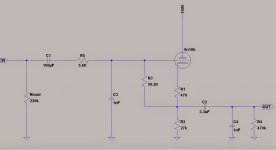hello guys,
i just got a nice condition nakmichi cd player 3. i would like to put a 6n16b buffer from this site: Mao Audiophile Modifications: Nakamichi CD Player 3 Lampized with 6n16b tube
my question is about the C1 capacitor which is 100uf on the attached schematic. is that a typo? i tried asking the author but with no response.
thanks
i just got a nice condition nakmichi cd player 3. i would like to put a 6n16b buffer from this site: Mao Audiophile Modifications: Nakamichi CD Player 3 Lampized with 6n16b tube
my question is about the C1 capacitor which is 100uf on the attached schematic. is that a typo? i tried asking the author but with no response.
thanks
Attachments
And also no reason for RloadAlso, no reason for 56k2 resistor. You can use 470k there.
Come to think about it, no reason for the hole circ(us)uit
Mona
My thought, too. Adding this circuit adds a little noise, hum and distortion and probably raises output impedance (so it may be an anti-buffer).Ketje said:Come to think about it, no reason for the hole circ(us)uit
And also no reason for Rload
Come to think about it, no reason for the hole circ(us)uit
Mona
The reason for "rload" is to discharge the cap, i.e. a bleeder actually. I would use all 3 resistors: on input, output, and grid leak of the same value, like 220k, to save money.
The reason for the circuit is, the majority of modern designers think of "voltage amplification" forgetting about power transfer. As the result, input/output impedances are non-linear, so a tube buffer "mismatch" them pretty well isolating power-wise from each other.
C4 should be omitted. Adding a capacitive load to a follower can cause instability.
Nonlinearity of impedances may not matter if they are large/small enough (as appropriate). A cathode follower is likely to have an output impedance which is higher and less linear than a correctly designed opamp circuit.
Nonlinearity of impedances may not matter if they are large/small enough (as appropriate). A cathode follower is likely to have an output impedance which is higher and less linear than a correctly designed opamp circuit.
As i understand it the thing has to be mounted inside the cabinet, the caps will discharge on the ins and outs.The reason for "rload" is to discharge the cap, i.e. a bleeder actually. I would use all 3 resistors: on input, output, and grid leak of the same value, like 220k, to save money.
The reason for the circuit is, the majority of modern designers think of "voltage amplification" forgetting about power transfer. As the result, input/output impedances are non-linear, so a tube buffer "mismatch" them pretty well isolating power-wise from each other.
If you lik to "isolate power-wise", put a j-fet in between
Mona
If you lik to "isolate power-wise", put a j-fet in between
Yes, one more option.
Why are you so strict in respect to people who are starting their DIY activity?
Last edited:
- Status
- This old topic is closed. If you want to reopen this topic, contact a moderator using the "Report Post" button.
- Home
- Amplifiers
- Tubes / Valves
- 6n16b buffer on a nakamichi cdp
